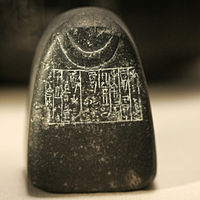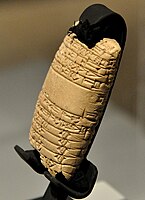Shulgi
| Shulgi 𒀭𒂄𒄀 | |
|---|---|
| |
| Father | Ur-Nammu |
| Mother | Watartum |
(c. 2094–2046 BC)
NIN-a-ni..................... "his Lady,"
SHUL-GI.................... "Shulgi"
NITAH KALAG ga...... "the mighty man"
LUGAL........................"King"
URIM KI ma............... "of Ur"
LUGAL ki en............... "King of Sumer"
gi ki URI ke................. "and Akkad,"
E a ni.......................... "her Temple"
mu na DU................... "he built"[4]
Shulgi (𒀭𒂄𒄀
Life and reign
Shulgi was the son of Ur-Nammu king of Ur and his queen consort Watartum. Year-names are known for all 48 years of his reign, providing a fairly complete contemporary view of the highlights of his career.[9]
Shulgi is best known for his extensive revision of the scribal school's curriculum. Although it is unclear how much he actually wrote, there are numerous praise poems written by and directed towards this ruler. He proclaimed himself a god in his 23rd regnal year,[10] and was recognized as such by the whole of Sumer and Akkad.[11]
Some early chronicles castigate Shulgi for his impiety: The Weidner Chronicle (ABC 19)[12] states that "he did not perform his rites to the letter, he defiled his purification rituals". CM 48[13] charges him with improper tampering with the rites, composing "untruthful stelae, insolent writings" on them. The Chronicle of Early Kings (ABC 20)[14] accuses him of "criminal tendencies, and the property of Esagila and Babylon he took away as booty."
Name
Early uncertainties about the reading of cuneiform led to the readings "Shulgi" and "Dungi" being common transliterations before the end of the 19th century. However, over the course of the 20th century, the scholarly consensus gravitated away from dun towards shul as the correct pronunciation of the 𒂄 sign. The spelling of Shulgi's name by scribes with the
-
Portraits of Shulgi from hisLouvre Museum
-
Portrait of Shulgi as a builder, on a foundation nail. Metropolitan Museum of Art
Personal glorification

Shulgi also boasted about his ability to maintain high speeds while running long distances. He claimed in his 7th regnal year to have run from Nippur to Ur, a distance of not less than 100 miles.[15] Kramer refers to Shulgi as "The first long distance running champion."[16]
Shulgi wrote a long royal hymn to glorify himself and his actions, in which he refers to himself as "the king of the four-quarters, the pastor of the black-headed people".[17]
Shulgi claimed that he spoke Elamite as well as he spoke Sumerian.[8]
Some scholars note how he self identified as a "mathematical god" and considers the state he ruled over as the "first mathematical state", citing his praise poems that emphasize his abilities in subtraction, addition calculation and accounting.[18]
Armed conflicts
While
Susa
(c. 2094–2047 BCE)
Shulgi is known to have made dedications at
The Ur III dynasty had held control over Susa since the demise of
-
Foundation nail dedicated by Shulgi to theLouvre Museum
-
Carnelian bead with dedicatory inscription by Shulgi, found in Susa. Louvre Museum, Sb 6627
Modernization
Shulgi apparently led a major modernization of the Third Dynasty of Ur.[8] He improved communications, reorganized the army, reformed the writing system and weight and measures, unified the tax system, and created a strong bureaucracy.[8] He also promulgated the law code known as the Code of Ur-Nammu after his father.[8]
Year names
There are extensive remains for the year names of Shulgi, which have been entirely reconstructed from year 1 to year 48. Some of the most important are:[37]
1. Year : Šulgi is king
2. Year: The foundations of the temple of Ningubalag were laid
6. Year: The king straightened out the Nippur road
7. Year: The king made a round trip between Ur and Nippur (in one day)
10. Year: The royal mountain-house (the palace) was built
18. Year: Liwirmittašu, the daughter of the king, was elevated to the queenship ofMarhashi
21c. Year: Der was destroyed
24. Year: Karahar was destroyed
25. Year: Simurrum was destroyed
27. Year after: "Šulgi the strong man, the king of the four corners of the universe, destroyed Simurrum for the second time"
27b. Year: "Harszi was destroyed"
30. Year: The governor ofAnšantook the king's daughter into marriage
31. Year: Karhar was destroyed for the second time
32. Year: Simurrum was destroyed for the third time
34. Year: Anshan was destroyed
37. Year: The wall of the land was built
42. Year: The king destroyed Šašrum
44. Year: Simurrum andLullubumwere destroyed for the ninth time
45. Year: Šulgi, the strong man, the king of Ur, the king of the four-quarters, smashed the heads of Urbilum, Simurrum, Lullubum and Karhar in a single campaign
46. Year: Šulgi, the strong man, the king of Ur, the king of the four-quarters, destroyed Kimaš, Hurti and their territories in a single day— Main year names of Shulgi[38]
Marriages
Shulgi was a contemporary of the Shakkanakku rulers of Mari, particularly Apil-kin and Iddi-ilum.[39][40] An inscription mentions that Taram-Uram, the daughter of Apil-kin, became the "daughter-in-law" of Ur-Nammu, and therefore the Queen of king Shulgi.[41][42] In the inscription, she called herself "daughter-in-law of Ur-Nammu", and "daughter of Apil-kin, Lugal ("King") of Mari", suggesting for Apil-kin a position as a supreme ruler, and pointing to a marital alliance between Mari and Ur.[43][44]
Nin-kalla was a queen at the end of the king's reign. Many texts show that she was running the palace in Nippur.[45] Another important royal woman, but not a queen, was Ea-niša. She appears in many texts and had an influential position at the royal court, perhaps as concubine.[46] A similar status had Shulgi-simti who is known from a high number of texts presenting evidence for her economic power. Another important woman was Geme-Ninlilla who appears in texts at the end of the king's reign. Other, less well known royal women are Šuqurtum and Simat-Ea.
Shulgi is known to have had five sons, Amar-dDa-mu, Lu-dNanna, Lugal-a-zi-da, Ur-dSuen, Amar-Sin as well as one daughter, Peš-tur-tur.[47][48] The name of another daughter, Šāt-Kukuti, is known from a cuneiform tablet.[49]
Artifacts and inscriptions
-
Lugal Urimkima/ Lugal Kiengi Kiuri 𒈗𒋀𒀊𒆠𒈠𒈗𒆠𒂗𒄀𒆠𒌵, "King of Ur, King of Sumer and Akkad, on a votive tablet of Shulgi. The final ke4 𒆤 is the composite of -k (genitive case) and -e (ergative case).[50]
-
Shulgi completed the great Ziggurat of Ur
-
Earrings inscribed in the name of Shulgi.[51]
-
Seal of Shulgi, with worshipper and seated deity: "Shulgi, the mighty hero, King of Ur, king of the four regions, Ur-(Pasag?) the scribe, thy servant".[52]
-
Mace head in the name of Shulgi (inscription upside down). British Museum.
-
Duck-shaped official weight of 2 mina, reign of Shulgi, from Ur, Iraq. British Museum.
-
Weight of +1⁄2 mina (actual weight 248 gr.) dedicated by King Shulgi and bearing the emblem of the crescent moon: it was used in the temple of the Moon-God at Ur. Diorite, beginning of the 21st century BC (Ur III). Louvre Museum, Department of Oriental Antiquities, Richelieu, first floor, room 2, case 6
-
Tablet of Shulgi, glorifies the king and his victories on the Lullubi people and mentions the modern-city of Erbil and the modern-district of Sulaymaniyah, Sulaymaniyah Museum, Iraq
See also
- Correspondence of the Kings of Ur
- History of Sumer
- Sumerian king list
- Self-praise of Shulgi
References
- ^ Full transcription: "CDLI-Archival View". cdli.ucla.edu.
- ^ "Nimintabba tablet". British Museum.
- ISBN 978-3-11-041300-7.
- ^ a b "(For the goddess) Nimintabba, his lady, Shulgi, mighty man, king of Ur, king of Sumer and Akkad, her house, built." in Expedition. University Museum of the University of Pennsylvania. 1986. p. 30.
- ISBN 9780195076189.
- ^ "Shulgi | king of Ur". Encyclopedia Britannica.
- ^ "Ur III Empire – Oxford Reference". Oxfordreference.com.
- ^ ISBN 9780521564960.
- ^ "T6K2.htm". Cdli.ucla.edu. Retrieved 7 August 2019.
- ^ Van De Mieroop, Marc. (2005). A History of the Ancient Near East ca. 3000–323 BC, Oxford: Blackwell Publishing, p. 76
- ISBN 0-393-00292-6.
- ^ "The Weidner Chronicle (ABC 19)". Archived from the original on 28 February 2006.
- ^ "The kings of Ur (CM 48)". Archived from the original on 10 May 2006.
- ^ "Chronicle of early kings (ABC 20)". Archived from the original on 28 February 2006.
- ^ a b Hamblin, William J. Warfare in the Ancient Near East to 1600 BC. New York: Routledge, 2006.
- ^ See his History Begins at Sumer, Chapter 31, "Shulgi of Ur: The First Long-Distance Champion".
- ISBN 978-1-134-75084-9.
- ^ "Red Traces, Part 11: The social origins of early mathematics". counterfire.
- ^ ISBN 978-0-226-45238-8.
- ^ Ghobadizadeh, Hamzeh and Sallaberger, Walther, "Šulgi in the Kuhdasht Plain: Bricks from a Battle Monument at the Crossroads of Western Pish-e Kuh and the Localisation of Kimaš and Ḫurti", Zeitschrift für Assyriologie und vorderasiatische Archäologie, vol. 113, no. 1, pp. 3-33, 2023
- ^ (RIME 3/2, p. 161-162)
- ^ "DINGIR.NIN.LILA / NIN-A-NI / DINGIR.SHUL.GI / NITA-KALAG.GA / LUGAL URI/ .KI-MA / LUGAL.KI.EN / GI KI-URI3.KI / NAM.TI.LA NI.SHE3/ A MU.NA.RU." Inscription Translation: "To Ninlil, his lady, Shulgi, mighty man, King of Ur, King of Sumer and Akkad, has dedicated (this stone) for the sake of his life." "cylinder seal / bead". British Museum.
- ^ "CDLI-Archival View". cdli.ucla.edu.
- ISBN 978-0-521-56496-0.
- ISBN 978-1-58839-043-1.
- ISBN 978-0-521-56496-0.
- ^ "CDLI-Found Texts Louvre Museum Sb 2881". cdli.ucla.edu.
- ^ "Votive Foundation Nails". dla.library.upenn.edu.
- ISBN 978-0-521-56496-0.
- ISBN 9780521564960.
- ^ "Site officiel du musée du Louvre". cartelfr.louvre.fr.
- ^ "Shulgi perle (color image)". Louvre Museum.
- ^ ISBN 978-1-4051-8988-0.
- ^ "Site officiel du musée du Louvre". cartelfr.louvre.fr.
- ^ "BnF – L'Aventure des écritures". classes.bnf.fr.
- ^ a b "Šulgi Year Names (Ist Ni 00394)". cdli.ox.ac.uk.
- ISBN 978-1-134-52062-6.
- ^ "Šulgi Year Names". cdli.ox.ac.uk.
- ISBN 978-1-62564-606-4.
- ISBN 978-1-883053-67-3.
- ISBN 978-1-5015-0522-5.
- ISBN 978-0-19-090303-9.
- ISBN 9789068317275.
- JSTOR 23295098.
- ^ T. M. Sharlach: An Ox of One's Own, Royal Wives and Religion at the Court of the Third Dynasty of Ur, Walter de Gruyter GmbH, Berlin/Boston 2017, ISBN 978-1-5015-1447-0, 102-115
- ^ T. M. Sharlach: An Ox of One's Own, Royal Wives and Religion at the Court of the Third Dynasty of Ur, Walter de Gruyter GmbH, Berlin/Boston 2017, ISBN 978-1-5015-1447-0, 140-157
- ^ Changyu Liu, "Prosopography of individuals delivering animals to Puzriš-Dagan in Ur III Mesopotamia", Akkadica 142/2, 2021, pp. 113-142
- ^ [1]Changyu Liu, "Prosopographical Statistics Appendix of the article 'Prosopography of individuals delivering animals to Puzriš-Dagan in Ur III Mesopotamia'", Cuneiform Digital Library Preprints, 24.0, 1 April 2022
- ^ Ali, Basil Bashar, and Khalid Salim Ismael, "Šāt-kukuti The Daughter of King Šulgi in a New Text from the Iraqi Museum", Athar Alrafedain 8.2, pp. 266-280, 2023
- ISBN 978-90-474-0340-1.
- ^ "CDLI-Archival View". cdli.ucla.edu.
- ^ a b Ward, William Hayes (1910). The seal cylinders of western Asia. Washington : Carnegie Inst. p. 27.
- ^ a b Simo Parpola, Asko Parpola and Robert H. Brunswig, Jr "The Meluḫḫa Village: Evidence of Acculturation of Harappan Traders in Late Third Millennium Mesopotamia?" in Journal of the Economic and Social History of the Orient Vol. 20, No. 2, 1977, p. 136-137
- ^ "Collections Online British Museum". britishmuseum.org.
External links
- Shulgi's axe sold illegally in Germany from the German Middle East magazine zenith
- The face of Shulgi. A realistic statue shows us how Shulgi may have looked in real life.



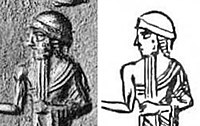
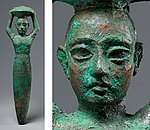
![Votive tablet of Shulgi, excavated in Susa: "For the goddess Ninhursag of Susa, his Lady, Shulgi, the great man, King of Ur, King of Sumer and Akkad, built her temple ". Louvre Museum, Sb 2884.[34][35]](http://upload.wikimedia.org/wikipedia/commons/thumb/5/55/Votive_tablet_of_Shulgi%2C_excavated_in_Susa%2C_SB_2880.jpg/150px-Votive_tablet_of_Shulgi%2C_excavated_in_Susa%2C_SB_2880.jpg)
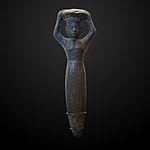
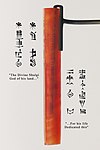
![Lugal Urimkima/ Lugal Kiengi Kiuri 𒈗𒋀𒀊𒆠𒈠𒈗𒆠𒂗𒄀𒆠𒌵, "King of Ur, King of Sumer and Akkad, on a votive tablet of Shulgi. The final ke4 𒆤 is the composite of -k (genitive case) and -e (ergative case).[50]](http://upload.wikimedia.org/wikipedia/commons/thumb/b/b9/Lugal_Urimkima_Lugal_Kiengi_Kiuri%2C_King_of_Ur%2C_King_of_Sumer_and_Akkad%2C_on_a_seal_of_Shulgi_%28transcription%29.jpg/200px-Lugal_Urimkima_Lugal_Kiengi_Kiuri%2C_King_of_Ur%2C_King_of_Sumer_and_Akkad%2C_on_a_seal_of_Shulgi_%28transcription%29.jpg)
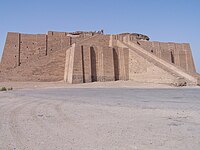
![Earrings inscribed in the name of Shulgi.[51]](http://upload.wikimedia.org/wikipedia/commons/thumb/c/ce/Earrings_from_Shulgi.JPG/200px-Earrings_from_Shulgi.JPG)
![Seal of Shulgi, with Gilgamesh fighting a winged monster: "To Shulgi, son of the king, Ur-dumuzi the scribe, his servant".[52]](http://upload.wikimedia.org/wikipedia/commons/thumb/d/dc/Seal_of_Shulgi%2C_with_Gilgamesh_fighting_a_winged_monster.jpg/200px-Seal_of_Shulgi%2C_with_Gilgamesh_fighting_a_winged_monster.jpg)
![Seal of Shulgi, with worshipper and seated deity: "Shulgi, the mighty hero, King of Ur, king of the four regions, Ur-(Pasag?) the scribe, thy servant".[52]](http://upload.wikimedia.org/wikipedia/commons/thumb/f/fb/Seal_of_Shulgi%2C_with_worshipper_and_seated_deity.jpg/200px-Seal_of_Shulgi%2C_with_worshipper_and_seated_deity.jpg)


![A tablet from the period of Shulgi, mentioning the "Meluhha" village in Sumer. British Museum, BM 17751.[53] "Meluhha" (𒈨𒈛𒄩𒆠) actually appears on the beginning of the other side (column II, 1) in the sentence "The granary of the village of Meluhha".[54][53]](http://upload.wikimedia.org/wikipedia/commons/thumb/7/79/Meluhha_village_tablet_-_BM17751.jpg/142px-Meluhha_village_tablet_-_BM17751.jpg)
